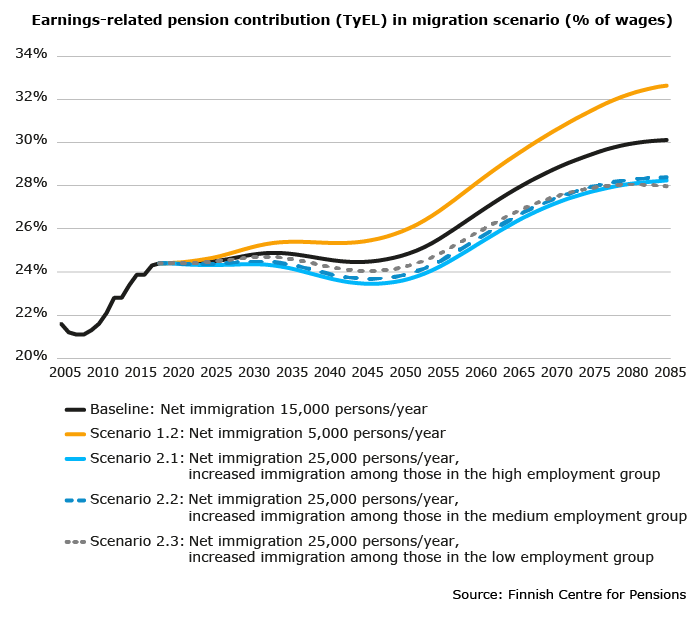Increased immigration would strengthen pension finances

In the long run, the declining birth rates cause a strong upward pressure on pension contribution rates. A major increase in immigration or an equivalent reduction in migration, on the other hand, would ease the pressure by several percentage points. The magnitude of the impact depends on the employment outcome of the various groups of immigrants. According to scenario calculations of migration, a decrease in net immigration would weaken pension finances.
The Finnish Centre for Pensions has estimated the impact of net migration on pension system sustainability through scenario calculations. The baseline scenario is based on the long-term projections for 2019–2085 by the Finnish Centre for Pensions. It is varied by adding or subtracting net migration by 10,000 persons per year. One of the scenarios involved a reduced migration rate.
The overall impact on the sustainability of public finances has been excluded from the calculations.
The baseline projection of the Finnish Centre for Pensions follows Statistics Finland’s population projection from 2018. If population trends continue according to that projection, the earnings-related pension contribution (under the Employees’ Pensions Act, TyEL) will have to be raised from the current 24-25 per cent to more than 30 per cent in the latter half of the century.
The population projection assumes a net immigration of 15,000 persons a year. An increase of 10,000 persons in net immigration would reduce the upward pressure on pension contributions by around two percentage points by the end of the projection period. In the near decades, the pension contribution would be reduced the most in a scenario with a considerable decrease in migration.
“A net immigration that is higher than it is today could compensate for the upward pressure on pension contributions caused by declining birth rates. The magnitude of the effect depends on the employment outcome of the immigrants,” says director Jaakko Kiander of the Finnish Centre for Pensions.
Reduced immigration would weaken pension finances. If the net immigration rate were to be reduced by 5,000 persons a year, the ratio of pension recipients to working people would grow and pension contributions would have to be increased already in the 2030s.
At the end of the projection period, the contribution would be more than two percentage points higher than in the baseline projection.
Differences in immigrants’ employment outcome
For illustrative scenarios, the immigrants were classified into three groups based on their country of birth: high, medium and low employment outcome. The Human Development Index (HDI) was used in the classification. It relates to the employment outcome of immigrants. In the three different scenarios, the growth in immigration comes from only one group at a time.
If the increase in the number of immigrants occurs in the high or medium employment outcome groups, the earnings-related pension contribution would be reduced by around one percentage point by the mid-2040s.
Increased immigration in the low employment outcome groups would reduce the contribution less until the end of the 2060s.
In the long run, the different scenarios draw closer to each other and the gaps in employment rates between the source countries disappear. As a result, the earnings-related pension contribution towards the end of the projection period is about two percentage points lower than in the baseline scenario in all three immigration scenarios.
“Immigrants in the low employment outcome group are more fertile than the immigrants of the other groups. Their children are expected to have a better employment outcome than their parents, which will increase the number of employed and even out the gaps in the scenarios in the long run,” explains mathematician Tuija Nopola of the Finnish Centre for Pensions.

Scenarios of impact of migration on pension system sustainability
- The scenario calculations illustrate the effect of immigration and migration on pension system sustainability.
- The scenarios are not projections or recommendations.
- The differences between the immigrant groups and the original population in the scenarios are based on realised data derived from administrative registers.
Calculated scenarios:
- Baseline: Net immigration 15,000 persons a year
- 1.1: Net immigration 25,000 persons a year, immigrants from all groups
- 1.2: Net immigration 5,000 persons a year
- 2.1: Net immigration 25,000 persons a year, increased immigration among those in the high employment group
- 2.2: Net immigration 25,000 persons a year, increased immigration among those in the medium employment group
- 2.3: Net immigration 25,000 persons a year, increased immigration among those in the low employment group
- 3: Net immigration 25,000 persons a year, emigration reduced by 10,000 persons
More information:
Director Jaakko Kiander, phone + 358 29 411 2414, firstname.lastname(at)etk.fi
Mathematician, Tuija Nopola, phone +358 29 411 2217, firstname.lastname(at)etk.fi